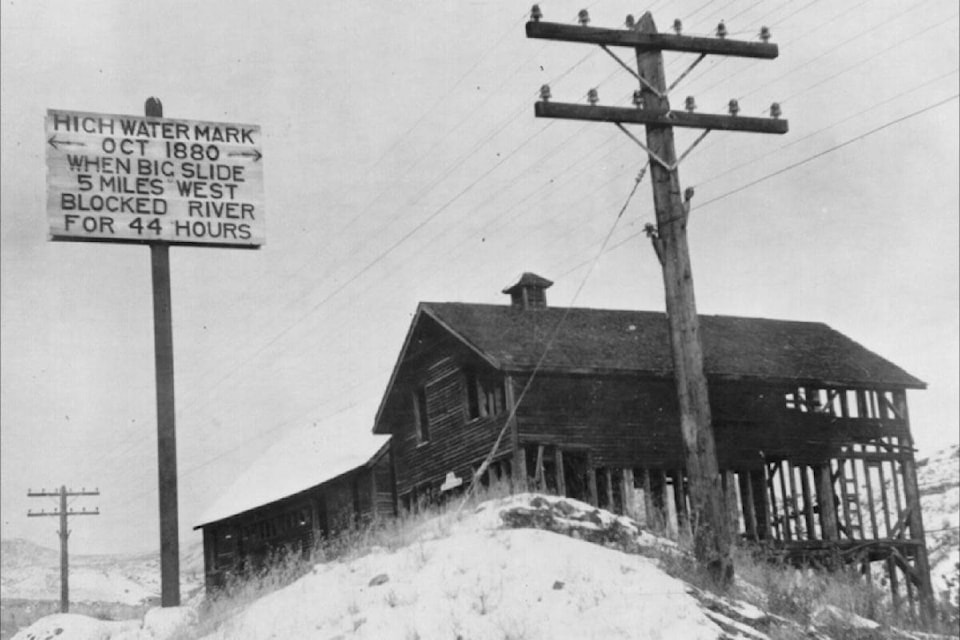If you believe in omens, either for good or ill, an event which happened only a year or so after Thaddeus Harper opened a grist mill at the mouth of the Bonaparte River where it meets the Thompson could be taken as a very bad omen indeed.
On Oct. 14, 1880 a massive landslide occurred at an area of the Thompson five miles south of the mill known as Black Canyon. It is a narrow gorge with steep rock cliffs on either side, with nowhere for the water to go other than through the channel, so when the area was choked with thousands of tons of debris the water of the Thompson — unable to get through the obstacle — began backing up on the north side of it.
In 1880 there was no town of Ashcroft, which had yet to be built on the flat bench it now occupies four miles upstream from the slide. The area where the town would be built was, at that time, ranched by John Barnes and William Brink, who had some outbuildings there, along with Barnes’s home. The few eyewitnesses to the aftermath of the slide reported that while the Thompson was almost completely dry to the south of the landslide, the water was backed up to a height of 60 feet on the north side. The area where the downtown part of Ashcroft now sits was flooded to a depth of one-and-a-half feet, washing away several outbuildings and Barnes’s home, and the swiftly rising water was an imminent threat to Harper’s Mill, which soon found itself half-submerged in water.
R.T. Ward, the mill’s manager, knew that prompt action was needed if the mill was to be saved. He mustered a team of men and, armed with hand tools, they proceeded downriver to the slide site and began digging a channel through the top of the debris. It took several hours of undoubtedly back-breaking work, but eventually they cleared enough of a path that the pent-up water was once again able to flow through, with the force of the current swiftly washing away rocks and dirt and restoring the channel to something more like normal. Some 48 hours after the slide, the Thompson was flowing once more.
Thus it was that Harper’s Mill was saved, although it took some time for the building to be cleaned and to dry out. For many years after, a wooden sign stood beside the mill, reading “High Water Mark — October 1880 — When Big Slide Five Miles West Blocked River For 44 Hours”, with arrows denoting the height the water reached. That sign still stands beside the CN track tha now runs past the site of the mill, and another wooden sign — which in a photograph taken in the 1930s is visible on the building itself — also survives. It states “Big Slide 1880 High Watermark”, and can be viewed in the Ashcroft Museum.
The mill had had a narrow escape, and Harper probably turned his thoughts to what he hoped would be an improved future for his mill and its product. Transportation was a key issue: how to get his flour to market? Transportation via pack train and the Cariboo Waggon Road was costly and cumbersome. What about the river? Steamboats were active on Kamloops Lake, and in 1881 a scheme to bring boats down the Thompson as far as Spences Bridge was floated (pun intended).
The idea was that a boat would be able to take supplies to the camps of railway workers that were springing up along the river, more easily and less expensively than shipping supplies by road. The boat would also be able to transport goods, such as produce from the Spences Bridge area and flour from Harper’s Mill, back to Savona and Kamloops.
It sounded promising, and in June 1881 a paddlewheeler called Peerless departed Savona for Spences Bridge in a trial run to see if the river was navigable. She measured 131 feet long and 25 feet wide, with a shallow draft suitable (it was hoped) for the Thompson, and the boat would have been an impressive sight as it rounded the bend of the river at the Slough and proceeded past the mill, past the ranches of Barnes and Evans, and down toward Spences Bridge.
The downstream trip was uneventful, and all looked promising. The Peerless turned around and began the journey north, which was considerably more perilous, with the boat having to navigate against the swift flow of the river. However, all was well until the Peerless entered Black Canyon.
Perhaps she would have fared better before the Big Slide deposited tons of debris in the river at that point, making an already treacherous spot even more dangerous; or perhaps the scheme was always destined to fail. Either way, the Peerless struggled mightily against the fierce current in Black Canyon, and only the captain’s skill kept the boat from smashing to pieces. Captain, crew, and boat emerged unscathed, but considerably shaken, and that was the end of the idea of a water route from Savona down the Thompson River.
There was still another prospect for transportation: the Canadian Pacific Railway, which would be built along the Thompson River past the site of Harper’s Mill. All Thaddeus Harper could do was sit and wait to see which side of the river would be chosen for the route.
Next time: Would Harper’s Mill be on the right or wrong side of the Thompson?
editorial@accjournal.ca
Like us on Facebook and follow us on Twitter
